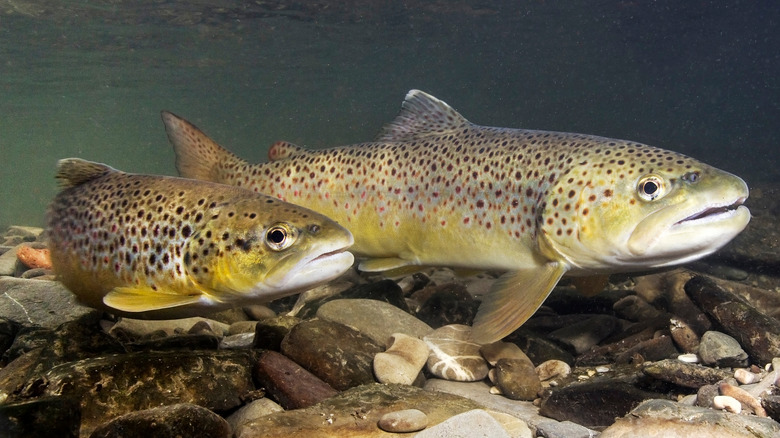The Truth About Drug Addicted Fish
It's never a good idea to flush drugs down the toilet or pour them down the sink. Per the Minnesota Pollution Control Agency, pharmaceuticals can contaminate lakes and streams, as wastewater treatment systems aren't designed to remove medications and other drugs from the water. Not only can drugs end up in our water supply, but they can also hurt fish and other aquatic life by poisoning them and exposing them to endocrine disrupting compounds, which are found in antidepressants and medicines containing hormones. This can mess up a fish's growth and reproductive systems.
Nevertheless, the FDA does note that you should follow directions on your medications for disposal, indicting that there are times it's warranted. They even have a "flush list" of pharmaceuticals that they recommend flushing down the toilet because they are sought after for misuse and abuse, or one dose is potentially fatal, including several opioids. The site references a 2017 paper with findings that indicate the flush list medications present negligible environmental risks but notes that additional data would be helpful in confirming the relative safety of flushing drugs.
A July 2021 study published in the Journal of Experimental Biology might contain some useful additional data regarding the effects of drugs on fish. In their study "Methamphetamine pollution elicits addiction in wild fish," Pavel Horký, of the Czech University of Life Sciences Prague, told the journal, "Whether illicit drugs alter fish behavior at levels increasingly observed in surface water bodies was unclear," so he and his study co-authors performed an experiment in which they exposed brown trout to methamphetamine to determine whether they were at risk of addiction from meth found in their waterways.
What happens when fish are exposed to meth?
Per the Journal of Experimental Biology, Pavel Horký and his colleagues isolated brown trout for eight weeks in a tank in which the water was laced with the same amount of methamphetamine that has been found in freshwater rivers. At the end of the eight weeks, they transferred the fish to a freshwater tank and on every other day for 10 days, offered the fish the choice between remaining in freshwater or accessing water containing meth. The theory was that if the fish were experiencing withdrawal, they had become addicted to the drug and would seek it out when it was made available to them. Sure enough, the fish selected meth-laced water to relieve the withdrawal they experienced during the first four days in the freshwater tank.
Horký noted that in addition, the fish that had been exposed to meth were less active than those who had not, and the scientists found evidence of the drug in the exposed trouts' brains up to 10 days after they'd been removed from the laced tank. Furthermore, it's possible that wild fish that become addicted to meth will attempt to gather at water treatment discharges to access drug-infested water and will disrupt their natural life cycles. Per Horký, "The elicitation of drug addiction in wild fish could represent another example of unexpected pressure on species living in urban environments."
It seems that the risks to aquatic life that stem from both legal and illegal drugs finding their way into water supplies warrant more attention.
If you or anyone you know is struggling with addiction issues, help is available. Visit the Substance Abuse and Mental Health Services Administration website or contact SAMHSA's National Helpline at 1-800-662-HELP (4357).

